近几十年来NAO变率和韩国夏季极端高温的年代际变化
IF 6.9
1区 地球科学
Q1 METEOROLOGY & ATMOSPHERIC SCIENCES
引用次数: 0
摘要
从20世纪90年代末到2010年代初,韩国经历了一段热浪的间歇期(称为“P1”),随后在2010年代初出现了严重的热浪(称为“P2”)。尽管全球持续变暖,但为了理解这种年代际变化,我们研究了韩国热浪与北大西洋涛动(NAO)变率的年代际变化之间的联系。响应NAO,源自格陵兰岛的行星尺度波主要在年际尺度上影响欧洲、东北亚(包括朝鲜半岛)和北美的大气环流。具体而言,正的NAO相位增强了朝鲜半岛的反气旋环流,增加了地表温度和热浪频率。在P1期间,受遥远的热带太平洋强迫影响,NAO呈下降趋势,年际变率减小。我们的研究结果还表明大西洋强迫在P2期间对NAO上升趋势的潜在影响,以及热带太平洋强迫的相移。这些发现强调了由NAO趋势、热带太平洋强迫和北大西洋强迫之间的复杂相互作用形成的大尺度气候变化,以及人为强迫的潜在贡献,在驱动当地极端高温的年代际波动方面的作用,特别是在韩国。本文章由计算机程序翻译,如有差异,请以英文原文为准。
Decadal swing in NAO variability and summertime heat extremes in South Korea over recent decades
South Korea experienced a lull in heatwave occurrences from the late 1990s to the early 2010s (referred to as “P1”), followed by significant heatwaves in the early 2010s (referred to as “P2”). To understand this decadal variation despite ongoing global warming, we examined the link between heatwaves in South Korea and decadal shifts in North Atlantic Oscillation (NAO) variability. Planetary-scale waves originating from Greenland in response to the NAO influence atmospheric circulation across Europe, Northeast Asia (including the Korean Peninsula), and North America, primarily on interannual scales. Specifically, positive NAO phases enhance anticyclonic circulations over the Korean Peninsula, increasing surface temperatures and heatwave frequency. During P1, the NAO exhibited a declining trend and reduced interannual variability, influenced by remote tropical Pacific forcing. Our results also suggested the potential influence of the Atlantic Ocean forcing on the rising trend of the NAO during P2, alongside a phase shift in tropical Pacific forcing. These findings highlight the role of large-scale climate variability—shaped by complex interactions among NAO trends, tropical Pacific forcing, and North Atlantic forcing, with potential contributions from anthropogenic forcing—in driving the decadal fluctuations in local heat extremes, particularly in South Korea.
求助全文
通过发布文献求助,成功后即可免费获取论文全文。
去求助
来源期刊

Weather and Climate Extremes
Earth and Planetary Sciences-Atmospheric Science
CiteScore
11.00
自引率
7.50%
发文量
102
审稿时长
33 weeks
期刊介绍:
Weather and Climate Extremes
Target Audience:
Academics
Decision makers
International development agencies
Non-governmental organizations (NGOs)
Civil society
Focus Areas:
Research in weather and climate extremes
Monitoring and early warning systems
Assessment of vulnerability and impacts
Developing and implementing intervention policies
Effective risk management and adaptation practices
Engagement of local communities in adopting coping strategies
Information and communication strategies tailored to local and regional needs and circumstances
 求助内容:
求助内容: 应助结果提醒方式:
应助结果提醒方式:


